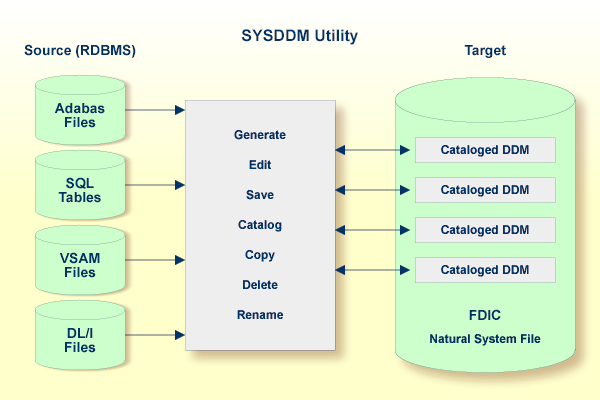The SYSDDM utility is used to create a Natural DDM from a database file or from another DDM. A Natural object (for example, a program or a data area) can only access a database file if a corresponding DDM has been created for this file and saved as a cataloged object. For further details on Natural DDMs, see Data Definition Modules - DDMs in the Programming Guide.
The following graphic illustrates the main features and basic principles of operation when processing DDMs with the SYSDDM utility:

This section provides general information on storing and accessing DDMs and the restrictions that can apply to using SYSDDM utility functions.
DDMs are stored in the Natural system file FDIC. The FDIC system file collects all DDMs available in your Natural system environment. You can only store and access DDMs in the FDIC system file.
DDMs are not restricted to files stored in an Adabas database. Some options described in the SYSDDM Utility documentation only apply to Adabas and can be ignored if a different database management system is used.
The section below describes the restrictions that can apply to using SYSDDM utility functions under:
To guarantee data integrity for DDMs defined in Predict, the Predict administrator can restrict the use of SYSDDM utility functions for editing, copying, creating, deleting, renaming and cataloging, for which equivalent functions are provided by Predict.
In principle, we strongly recommend that you do not use any SYSDDM utility functions that can alternatively be performed by Predict.
For further information, contact your Predict system administrator.
Access to DDMs can be restricted when Natural Security has been installed. Within the DDM security profile, there may be a definition of whether a DDM may be modified only by specific users (DDM modifiers) or the owners of the security profile.
For further information, see Protecting DDMs On Mainframes in the Natural Security documentation.